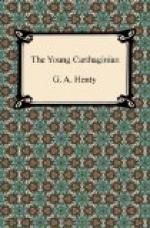The fact, too, that Scipio was wounded and unable to take part in the battle added to his desire to force it on, since the whole glory of the victory would be his. He therefore told his colleague that although he saw the force of his arguments, public opinion in Rome was already so excited at Hannibal having been allowed, without a battle, to wrest so wide a territory from Rome, that it was absolutely necessary that an action should be fought. The two armies were now united on the Trebia, and opinion was among the officers and troops, as between the consuls, widely divided as to the best course to be pursued.
Hannibal’s spies among the natives kept him acquainted with what was going on in the Roman camp, and he determined to provoke the Romans to battle. He therefore despatched two thousand infantry and a thousand cavalry to ravage the lands of some Gaulish allies of the Romans. Sempronius sent off the greater part of his cavalry, with a thousand light infantry, to drive back the Carthaginians.
In the fight which ensued the Romans were worsted. Still more furious, Sempronius marched to support them with his army. Hannibal called in his troops and drew them off before Sempronius would arrive. The disappointment and rage of the Roman general were great, and Hannibal felt that he could now bring on a battle when he would. He determined to fight in the plain close to his own position. This was flat and bare, and was traversed by the Trebiola. This stream ran between steep banks below the level of the plain; its banks were covered with thick bushes and reeds, and the narrow gap across the plain was scarce noticeable.
On the evening of the twenty-fifth of December Hannibal moved his army out from the camp and formed up on the plain facing the Trebia, ordering the corps commanded by his brother Mago to enter the bed of the Trebiola, and to conceal themselves there until they received his orders to attack. The position Mago occupied would bring him on the left rear of an army which had crossed the Trebia, and was advancing to attack the position taken up by Hannibal. Having thus prepared for the battle, Hannibal proceeded to provoke it.
At daybreak on the twenty-sixth he despatched a strong body of horsemen across the river. Crossing the Trebia partly by ford and partly by swimming, the Carthaginian horse rode up to the palisade surrounding the Roman camp, where, with insulting shouts and the hurling of their javelins, they aroused the Roman soldiers from their slumber. This insult had the desired effect, Sempronius rushed from his tent, furious at what he deemed the insolence of the Carthaginians, and called his troops to arms. With their accustomed discipline the Romans fell into their ranks. The light cavalry first issued from the palisade, the infantry followed, the heavy cavalry brought up the rear. The insulting Numidians had already retired, but Sempronius was now determined to bring on the battle. He marched down the river and crossed at a ford.




